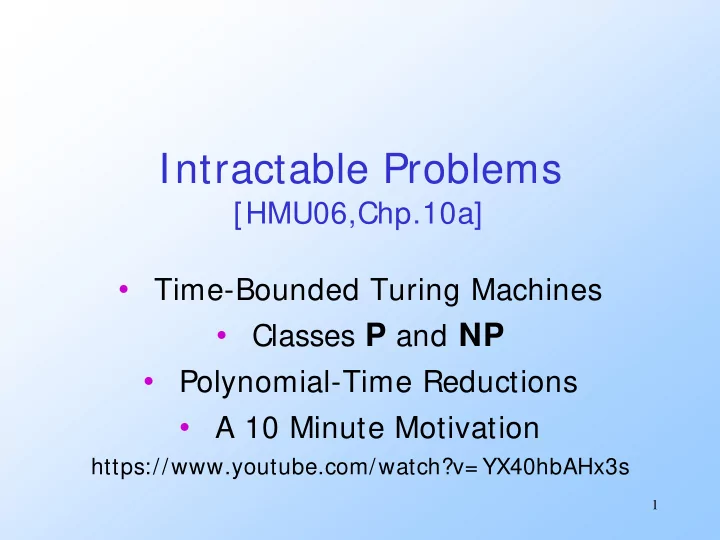

Intractable Problems [HMU06,Chp.10a] • Time-Bounded Turing Machines • Classes P and NP • Polynomial-Time Reductions • A 10 Minute Motivation https://www.youtube.com/watch?v= YX40hbAHx3s 1
Time-Bounded TM’s A Turing machine that, given an input of length n, always halts within T(n) moves is said to be T(n)-time bounded . The TM can be multitape. Sometimes, it can be nondeterministic. The deterministic, multitape case corresponds roughly to “an O(T(n)) running-time algorithm.” 2
The Class P 3
The class P If a DTM M is T(n)-time bounded for some polynomial T(n), then we say M is polynomial-time (“ polytime ”) bounded. And L(M) is said to be in the class P . Important point: when we talk of P , it doesn’t matter whether we mean “by a computer” or “by a TM” (next slide). 4
Polynomial Equivalence of Computers and TM’s A multitape TM can simulate a computer that runs for time O(T(n)) in at most O(T 2 (n)) of its own steps. If T(n) is a polynomial, so is T 2 (n). 5
Examples of Problems in P Is w in L(G), for a given CFG G? Input = w. Use CYK algorithm, which is O(n 3 ). Is there a path from node x to node y in graph G? Input = x, y, and G. Use Dijkstra’s algorithm, which is O(n log n) on a graph of n nodes and arcs. 6
Running Times Between Polynomials You might worry that something like O(n log n) is not a polynomial. However, to be in P , a problem only needs an algorithm that runs in time less than some polynomial. Surely O(n log n) is less than the polynomial O(n 2 ). 7
A Tricky Case: Knapsack The Knapsack Problem is: given positive integers i 1 , i 2 ,…, i n , can we divide them into two sets with equal sums? It appears no algorithm can solve Knapsack in polynomial time. 8
The Class NP 17
The Class NP The running time of a nondeterministic TM is the maximum number of steps taken along any branch. If that time bound is polynomial, the NTM is said to be polynomial-time bounded . And its language/problem is said to be in the class NP . 18
Example: NP The Knapsack Problem is definitely in NP , even using the conventional binary representation of integers. Use nondeterminism to guess one of the subsets. Sum the two subsets and compare. Others: Traveling Salesman Problem, and many others. 19
P Versus NP Originally a curiosity of Computer Science, mathematicians now recognize as one of the most important open problems the question P = NP ? There are thousands of problems that are in NP but appear not to be in P . But no proof that they aren’t really in P . Note: Problems in NP\ P are solvable in exponential time on a DTM. 20
Complete Problems One way to address the P = NP question is to identify complete problems for NP. An NP-complete problem has the property that if it is in P , then every problem in NP is also in P . Defined formally via “polytime reductions.” 21
Complete Problems – Intuition A complete problem for a class embodies every problem in the class, even if it does not appear so. Compare: PCP embodies every TM computation, even though it does not appear to do so. Strange but true: Knapsack embodies every polytime NTM computation. 22
Polynomial-Time Reductions 23
Polytime Reductions Goal: find a way to show problem L to be NP-complete by reducing every language/problem in NP to L in such a way that if we had a deterministic polytime algorithm for L , then we could construct a deterministic polytime algorithm for any problem in NP . 24
Polytime Reductions – (2) We need the notion of a polytime transducer – a TM that: 1. Takes an input of length n. 2. Operates deterministically for some polynomial time p(n). 3. Produces an output on a separate output tape . Note: output length is at most p(n). 25
Polytime Transducer state n input scratch tapes < p(n) output Remember: important requirement is that time < p(n). 26
Polytime Reductions – (3) Let L and M be languages. Say L is polytime reducible to M if there is a polytime transducer T such that for every input w to T, the output x= T(w) ∈ M iff w ∈ L. 27
Picture of Polytime Reduction in M in L T not not in M in L 28
NP-Complete Problems A problem/language M is said to be NP- complete if for every language L in NP , there is a polytime reduction from L to M. Fundamental property: if M has a polytime algorithm, then L also has a polytime algorithm. I.e., if M is in P , then every L in NP is also in P , or “ P = NP .” 29
The Plan All of NP polytime SAT polytime reduces to SAT, which reduces to is therefore NP-complete 3-SAT SAT 3- SAT NP 3-SAT polytime reduces to many other problems; they’re all NP-complete 30
Proof That Polytime Reductions “Work” Suppose M has an algorithm of polynomial time q(n). Let L have a polytime transducer T to M, taking polynomial time p(n). The output of T, given an input of length n, is at most of length p(n). The algorithm for M on the output of T takes time at most q(p(n)). 31
Proof – (2) We now have a polytime algorithm for L: 1. Given w of length n, use T to produce x of length < p(n), taking time < p(n). 2. Use the algorithm for M to tell if x is in M in time < q(p(n)). 3. Answer for w is whatever the answer for x is. Total time < p(n) + q(p(n)) = a polynomial. 32
Recommend
More recommend